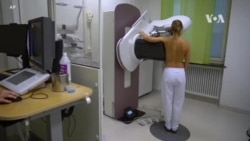ການຄົ້ນຄວ້າເມື່ອບໍ່ດົນມານີ້ໄດ້ພົບວ່າ ບັນດາແພດໝໍສາມາດທີ່ຈະກວດພົບໂຣກມະເຮັງໃນເຕົ້ານົມຫຼາຍຂຶ້ນກວ່າເກົ່າ ເວລາທີ່ເຂົາເຈົ້າໃຊ້ປັນຍາປະດິດ ຫຼື AI ເພື່ອຊ່ວຍອ່ານຜົນແອັກສ໌ເຣເຕົ້ານົມ. ດັ່ງທີ່ນັກຂ່າວວີໂອເອ ໂດຣາ ເມຄວາ ລາຍງານນັ້ນ, AI ສາມາດຊ່ວຍຂະຫຍາຍອັດຕາການກວດພົບໂຣກມະເຮັງໃນເຕົ້ານົມເຖິງຫຼາຍກວ່າ 17 ເປີເຊັນ.
ເວລາທີ່ບັນດາແພດໝໍໃຊ້ປັນຍາປະດິດ ຫຼື AI ເພື່ອກວດກາແອັກສ໌ເຣເຕົ້ານົມຂອງແມ່ຍິງ ຊາວເຢຍຣະມັນ ຫຼາຍກວ່າ 460,000 ຄົນ, ເຂົາເຈົ້າໄດ້ກວດພົບໂຣກມະເຮັງຕື່ມອີກນຶ່ງຊະນິດສຳລັບແມ່ຍິງທຸກໆ 1,000 ຄົນ ທີ່ໄດ້ເຂົ້າຮັບການກວດ ຊຶ່ງຫຼາຍກວ່າມະນຸດກວດພຽງຜູ້ດຽວ ອີງຕາມບັນດານັກຄົ້ນຄວ້າ. ການສຶກສານີ້ ທີ່ຖືກຕີພິມໃນວາລະສານ Nature Medicine ຖືເປັນການສຳຫຼວດໃນການໃຊ້ປັນຍາປະດິດກວດຫາໂຣກມະເຮັງໃນເຕົ້ານົມຢູ່ໂລກແຫ່ງຄວາມເປັນຈິງຄັ້ງໃຫຍ່ທີ່ສຸດ ຈົນເຖິງປັດຈຸບັນນີ້.
ດຣ. ອາເລັກແຊນເດີ ຄາຕາລີນິກ ຈາກມະຫາວິທະຍາໄລ ລູເບັກ ກ່າວວ່າ “ອັດຕາການກວດພົບໂຣກມະເຮັງແມ່ນດີຂຶ້ນກວ່າເກົ່າ, ແລະນີ້ແມ່ນຫຼັກຖານທີ່ໜັກແໜ້ນ. ແລະອີງຕາມຫຼັກຖານນີ້ ພວກເຮົາຄວນເລີ່ມໃຊ້ AI ໃນການກວດຫາມະເຮັງໃນເຕົ້ານົມຫຼາຍຂຶ້ນ ແລະ ໃນທີ່ສຸດນີ້ ຄວນກາຍເປັນມາດຕະຖານ.”
ແລະ ອັດຕາການກວດພົບທີ່ດີຂຶ້ນເກືອບ 18 ເປີເຊັນ, ພິສູດໃຫ້ເຫັນວ່າ AI ແມ່ນເໜືອກວ່າມະນຸດໃນການຄົ້ນຫາໂຣກມະເຮັງບໍ?
ດຣ. ອາເລັກແຊນເດີ ຄາຕາລີນິກ ກ່າວວ່າ “AI ແທ້ຈິງແລ້ວ ແມ່ນເໝາະສົມສຳລັບການເຂົ້າມາແທນຜູ້ອ່ານທີ່ເປັນມະນຸດໃນລະດັບນຶ່ງ ແຕ່ເຈົ້າຕ້ອງການໄປໄກຊ່ຳໃດ? ນີ້ບໍ່ແມ່ນແຕ່ຄຳຖາມທາງວິທະຍາສາດເທົ່ານັ້ນ ແຕ່ຍັງເປັນຄຳຖາມທາງສັງຄົມດ້ວຍ ສັງຄົມມີຄວາມເຊື່ອໝັ້ນໃນ AI ຫຼາຍໜ້ອຍຊ່ຳໃດ?”
AI ຍັງໄດ້ຊ່ວຍຫຼຸດຜ່ອນຈຳນວນຂອງຜົນອອກມາເປັນບວກທີ່ຜິດ. ປັນຍາປະດິດ ກໍໄດ້ມີຄວາມຜິດພາດໃນການກວດໂຣກມະເຮັງ ຈຳນວນນຶ່ງ.
ແຕ່ມະນຸດໄດ້ຜິດພາດຫຼາຍກວ່າ AI ເຖິງ 10 ເທົ່າ, ອີງຕາມຜົນການສຶກສາ.
ທ່ານ ສເຕຟານ ບັ້ງຄ໌, ຜູ້ຮ່ວມກໍ່ຕັ້ງບໍລິສັດ Vara ກ່າວວ່າ “AI ບໍ່ຄືມະນຸດ, ມັນບໍ່ຮູ້ຈັກເມື່ອຍແມ່ນບໍ່? ຂ້າພະເຈົ້າໝາຍຄວາມວ່າ, AI ເຮັດວຽກແບບວິທີດຽວກັນຕອນ 2 ໂມງເຊົ້າ ກັບໃນຕອນກາງເວັນ. ສະນັ້ນ, ແນ່ນອນມັນມີຄວາມໄດ້ປຽບ ແລະ ມັນຍັງເປັນນຶ່ງໃນຫຼາຍເຫດຜົນວ່າ ເປັນຫຍັງຂ້າພະເຈົ້າຈຶ່ງຄິດວ່າ AI ຈະພົບເຫັນໂຣກມະເຮັງທີ່ມະນຸດອາດຈະຜິດພາດ.”
ນີ້ແມ່ນຄວາມເປັນຫ່ວງທີ່ວ່າ ການນຳໃຊ້ AI ອາດນຳໄປສູ່ການມີແພດລັງສີວິທະຍາ ທີ່ໄດ້ຮັບການຝຶກຊ້ອມໜ້ອຍລົງໃນອະນາຄົດ.
ທ່ານ ສເຕຟານ ບັ້ງຄ໌ ກ່າວວ່າ “ກໍລະນີທີ່ຊັບຊ້ອນທີ່ວ່ານັ້ນ, ກໍລະນີທີ່ວ່າເຈົ້າ ຕ້ອງພິຈາລະນາຫຼາຍແງ່ມຸມ ທີ່ເຈົ້າຕ້ອງເວົ້າລົມກັບຄົນໄຂ້ ເປັນສິ່ງທີ່ຄວາມຊ່ຽວຊານ ແລະ ແພດດ້ານລັງສີວິທະຍາຕົວຈິງ ມີຄວາມສຳຄັນຫຼາຍ ແລະ ຄວນໄດ້ຮັບການຝຶກອົບຮົມຕໍ່ໄປ.”
ແຕ່ມັນກໍອາດມີຂໍ້ດີຈາກ ປັນຍາປະດິດເຊັ່ນກັນ.
ດຣ. ເຫວີຍ ຢາງ, ຈາກມະຫາວິທະຍາໄລ ເທັກຊັສ ກ່າວວ່າ “ຂ້າພະເຈົ້າຄິດວ່າ ການຖືກຳເນີດຂອງ AI ເປັນໂອກາດ ແລະ ເປັນແຮງກະຕຸ້ນໃຫ້ເຮົາຮູ້ສຶກຕື່ນເຕັ້ນກັບສາຂາຂອງພວກເຮົາຫຼາຍຂຶ້ນ. ສະນັ້ນບັນດາແພດລັງສີວິທະຍາທີ່ໄດ້ຮັບການຝຶກຊ້ອມເປັນຢ່າງສູງ ກໍຈະມີພື້ນທີ່ເປີດ, ເວລາ ແລະ ຄວາມຕັ້ງໃຈທີ່ເພັ່ງເລັງໃສ່ວຽກງານທີ່ມີຄວາມຊັບຊ້ອນຫຼາຍຂຶ້ນ.”
ດຣ. ເຫວີຍ ຢາງ ແມ່ນອາຈານສອນ ກ່ຽວກັບ ລັງສີວິທະຍາ ຢູ່ມະຫາວິທະຍາໄລ ເທັກຊັສ ຜູ້ທີ່ບໍ່ໄດ້ມີສ່ວນຮ່ວມໃນການສຶກສາ. ທ່ານນາງຮູ້ສຶກມີກຳລັງໃຈຈາກຜົນການສຶກສາ.
ດຣ. ເຫວີຍ ຢາງ ກ່າວວ່າ “ຂໍ້ມູນດັ່ງກ່າວ ໜ້າສົນໃຈຫຼາຍ. ອັດຕາການກວດພົບໂຣກມະເຮັງທີ່ເພີ່ມຂຶ້ນ, ການຫຼຸດລົງຂອງຜົນບວກທີ່ຜິດ ແລະ ຜົນກະທົບທີ່ອາດເກີດຂຶ້ນຕໍ່ກຳລັງແຮງງານ ແລະ ພາວະການອິດເມື່ອຍໃນການເຮັດວຽກໂດຍລວມແລ້ວ ເປັນໄປໃນທິດທາງບວກ.”
ສຳລັບຕອນນີ້, ການໃຊ້ແພດລັງສີວິທະຍາທີ່ເປັນມະນຸດ, ຄຽງຂ້າງກັບປັນຍາປະດິດ, ອາດເປັນວິທີທີ່ດີທີ່ສຸດ ທີ່ຈະສືບຕໍ່ສ້າງຄວາມແຂງແກ່ນໃຫ້ທັງສອງດ້ານ.
ດຣ. ອາເລັກແຊນເດີ ຄາຕາລີນິກ ກ່າວວ່າ “ການປະສົມປະສານຂອງມະນຸດກັບປັນຍາປະດິດ ແມ່ນດີກວ່າການມີພຽງແຕ່ຄົນອ່ານຜົນທີ່ເປັນມະນຸດເທົ່ານັ້ນ.”
ນັ້ນອາດເປັນໂອກາດທີ່ຈະນຳໄປສູ່ຜົນທີ່ດີກວ່າເກົ່າສຳລັບແມ່ຍິງ.
ອ່ານລາຍງານນີ້ເປັນພາສາອັງກິດ
A recent study found doctors were able to detect breast cancer more often when they used artificial intelligence to help read mammogram results.
When doctors used artificial intelligence to examine the mammograms of more than 460,000 German women, they found one more cancer for every one-thousand women tested than humans alone did, according to researchers. The study in the journal Nature Medicine is the largest real-world exploration to date into the use of AI to help detect breast cancer.
“The breast cancer detection rate is better, and this is really strong evidence. And based on this evidence, we should start to use more AI in breast cancer screening, and, in the end, this should be standard.”
And does that improved detection rate - of almost 18% - prove that AI is superior to humans at finding breast cancer?
“AI really is suitable for replacing human readers to a certain extent. But how far do you want to go? This is not only a question of science, it's also a social question. How is the society’s trust in AI?”
AI also helped reduce the number of false positive results. Artificial intelligence did miss some cancers.
But humans missed them 10 times more than the AI did, according to the study results.
“AI, unlike humans, doesn't get tired, right? I mean, AI works in the same way at 2:00 AM in the morning as in the middle of the day. So, it's definitely an advantage and it's also one of the reasons why I think AI finds cancers that otherwise humans would miss.”
There is concern that using AI in cancer detection could lead to fewer trained radiologists over time.
“Those complex cases, those cases where you need to take into account multiple angles, where you need to talk to the patient is something where expertise and an actual radiologist is very important and should continue to be trained.”
“I think that the advent of AI is an opportunity and a trigger for us to become more excited about our field.”
“So that highly trained radiologists will have the open space, the time and the concentration to focus on more complex tasks.”
Dr. Wei Yang is a professor of radiology at the University of Texas who was not involved in the study. She is encouraged by the results.
“The data is very compelling. The increased cancer detection rate, the reduction in the false positive callbacks and the potential impact this can have on workforce and burnout. So overall, very, very positive.”
For now, using a human radiologist, along with artificial intelligence, might be the best way to combine the strength of both.
“The combination of a human together with AI is much better than only having the human reading.”
Potentially leading to better outcomes for women.






ຟໍຣັມສະແດງຄວາມຄິດເຫັນ